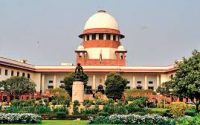$100 Website Offer
Get your personal website + domain for just $100.
Limited Time Offer!
Claim Your Website NowIn a first, single judge Supreme Court bench to hear bail appeals
Source: hindustantimes.com
Over 69 years after it came into existence, the Supreme Court of India will, for the first time, have a judge sitting singly to decide on matters of bail and anticipatory bail — in cases which carry a punishment of up to seven years’ imprisonment — and transfer of cases form one state to another.
Supreme Court Rules 2013 have been amended to allow the Chief Justice of India (CJI) to nominate any apex court judge and constitute a single-judge bench. The notification of the changes introduced in the rules was published in the Gazette of India on September 19.
The move, aSupreme Court registry official said, is aimed at bringing down pendency in the top court. It is not yet clear how many such benches would be set up by the CJI. On Monday, four new judges would be administered the oath, taking up the strength of the apex court to 34.
Several transfer petitions related to matrimonial disputes have choked the system and increase the number of cases awaiting final decisions.
“Such matters can be disposed of quickly by a single judge,” the official cited above said on condition of anonymity.
At present, single-judge benches sit on Mondays and Fridays to hear routine matters such as applications to condone delays in refiling a petition after defects are rectified, to exempt a petitioner from surrendering in a criminal case or allowing more time to remove defects in petitions and applications for renewal of fixed deposits. The new rule would allow single judges to now decide cases on the judicial side.
“The following category of matters may be heard and disposed off finally by a judge sitting singly , nominated by the Chief Justice of India, Special Leave Petitions arising out of grant, dismissal or rejection of Bail Application or Anticipatory Bail Application filed under Sections 437, 438 and 439 of Code of Criminal Procedure involving offences punishable with sentence up to seven years imprisonment. Application for transfer of cases under Section 406 of Code of Criminal Procedure. Application of an urgent nature for transfer of cases under Section 25 of the Code of Civil Procedure. Any other category of cases notified by the Chief Justice from time to time,” the notification reads.
Since 1950, when the Supreme Court of India replaced the Federal Court after independence from British rule, the tradition has been for judges to decide on cases sitting on a two- or more than two-judge benches.
Explaining the Supreme Court practice, Supreme Court senior advocate, Sanjay Hegde, said:“Earlier, Supreme Court judges used to sit singly only during vacations. And the judge sitting singly only decided matters on an ad interim basis. The final adjudication happened by a bench where judges sat in a combination of two or more judges. It was justice Krishna Iyer, who, sitting singly during vacation, in the Indira Gandhi election case, stayed her disqualification by the Allahabad high court.”
“The object behind the recent move seems to be to reduce the pendency of cases. The rationale of having judges sit in a combination of two or more has been to safeguard against error in administration of justice. Supreme Court being the last court of appeal, it was thought that better to have two or more judges decide an issue finally than a single judge. This [single-judge bench system] is likely to cause some problems,” added Hegde.
Bar Council of India chairman, Manan Kumar Mishra, is critical of the new rules and says the move to have just one judge decide bail and transfer matters is not a healthy practice. He says that bail and transfer matters cannot be taken lightly.
“The Bar, which is an important stakeholder in administration of justice, should at least have been consulted before effecting the changes. The whole idea of having two judges finally decide a matter was that two heads are better than one. But now this too has been done away. Lower courts and high courts of late have become very conservative in their approach while deciding bail/ anticipatory bail matters and the last hope was from the Supreme Court. Now, the new rules will usher in a new regime of justice administration.”



